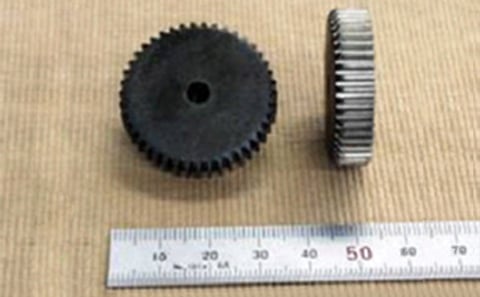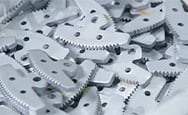POINT A fine blanking press offers the advantage of obtaining a smooth shear surface and eliminating the need for post-treatment. Although this technology was limited in terms of gear specifications that could be processed, the Company took on the challenge of manufacturing small module gears that exceeded the limit of the technology to meet stronger needs in the future. We have established a technology that enables stable punching even when the plate thickness is about 10 times that of the module.
Background to the research
Taking on the challenge of manufacturing small module gears with a fine blanking press to meet stronger needs in the future
The advantage of punching is that you can form the same shape repeatedly. Although there is an initial cost for mold manufacturing, the total cost can be reduced at the time of mass production. However, in general punching, cracks in the cut end surface cannot be avoided. When a cut end surface is used as a functional part, such as in a gear, cutting and other secondary processes are required in post-treatment, and this increases the manufacturing period and cost for the treatment required.
A fine blanking (FB) press solves this problem. The material is punched while being constrained by pressure from downward and upward directions, and a smooth shear surface is realized using the hydrostatic pressure effect. No secondary processing as post-treatment is required, and high-precision parts can be manufactured in a short period of time. The Fine-Blanking Industry Div. of MITSUI MIIKE MACHINERY focused on this FB press technology and has been mass-producing gears for automobiles and agricultural machinery for over 50 years.
While an FB press offers many advantages, considering the strength of the mold, this technology limits specifications as it is generally recognized to accommodate thickness of up to approximately three times that of the module. In addition, since the smaller the gear module the more prone to cracking the mold becomes, there have been cases where the FB press method could not be applied. On the other hand, there is growing demand for downsizing and strengthening of various equipment components, and demand for gears with smaller modules is expected to increase in the electric and automobile industries also going forward.
Given these circumstances, MITSUI MIIKE MACHINERY redoubled its efforts in technical research concerning FB press technology and worked to develop a method to manufacture gears with smaller modules using an FB press.
Innovative efforts and challenges
Repeating trial and error over cutting edges and treatment methods in addition to striving for enhanced precision of molds
MITSUI MIIKE MACHINERY set a goal of its research to achieve an FB press that can accommodate materials with a thickness of about 10 times that of the module and establish a method for stable mass production of small module gears. Our aim after developing this technology was to emphasize our technology’s advantage of eliminating the need for post-treatment which contributes to reducing construction time and costs and capture new orders targeting the electrical machinery and automobile industries.
We made innovative efforts in our research particularly for the following three points:
- High-precision mold manufacturing technology
- Cutting edge shape and processing method for preventing cracks in the punched surface
- Punching method that does not concentrate the load so as not to damage the mold
The first step was the development of a method to avoid damage caused by a load being concentrated on the mold. Molds broke frequently in the initial stage, but we worked to find out the cause of the breakage and tried to develop a pressing method that does not cause load concentration by repeatedly designing, manufacturing and modifying the mold. We also succeeded in suppressing the occurrence of cracks on the punched surface, which occurred frequently in the same way in the initial stage, by repeating trial and error regarding the shape of the cutting edge and the pressing method.
Once we were comfortable with the method taking shape, we made creative efforts to stabilize the technology to a level that enabled mass production. We needed to combine various conditions such as higher precision in mold manufacturing, selection of press oil, and treatment of the mold surface from a comprehensive viewpoint, and the research was extremely challenging. However, as a result of continuing efforts in technology development for six months, we finally established a method that allowed stable mass production of small module gears.
Results and future prospects
Establishment of FB press technology capable of stable punching even when handling thickness about 10 times that of module
The FB press technology established as an outcome of our research can punch through a plate with thickness of about 10 times that of the module. It is the only such technology and is unrivaled by other companies in the same industry at present. Small module gears, which are normally manufactured by combining multiple machining processes, can now be manufactured only with an FB press, realizing short delivery times and lower costs. This technology has been attracting keen attention from customers and exhibitions, contributing to widely highlighting MITSUI MIIKE MACHINERY’s technological capabilities. We have already received orders from new customers in sectors we had not done business with before.
It is a major positive factor for MITSUI MIIKE MACHINERY that the Company is now able to comfortably receive orders for gears with specifications that it had previously had to decline due to difficulties in accommodating such specifications. In addition, we believe that the enhanced mold manufacturing technology achieved in this research will lead to improving the technical capabilities of precision equipment itself on top of improving the precision of molds, reducing defects, and raising productivity throughout the company. Since the technology achieved through this research can be applied not only to gears but also to parts with small, narrow sections, we are proceeding with its application to parts other than gears.
In the future, we will continue research to further expand the application scope of an FB press by more deeply examining the basic technology. By further upgrading MITSUI MIIKE MACHINERY’s FB press technology, we aim to expand the market and win new orders.


